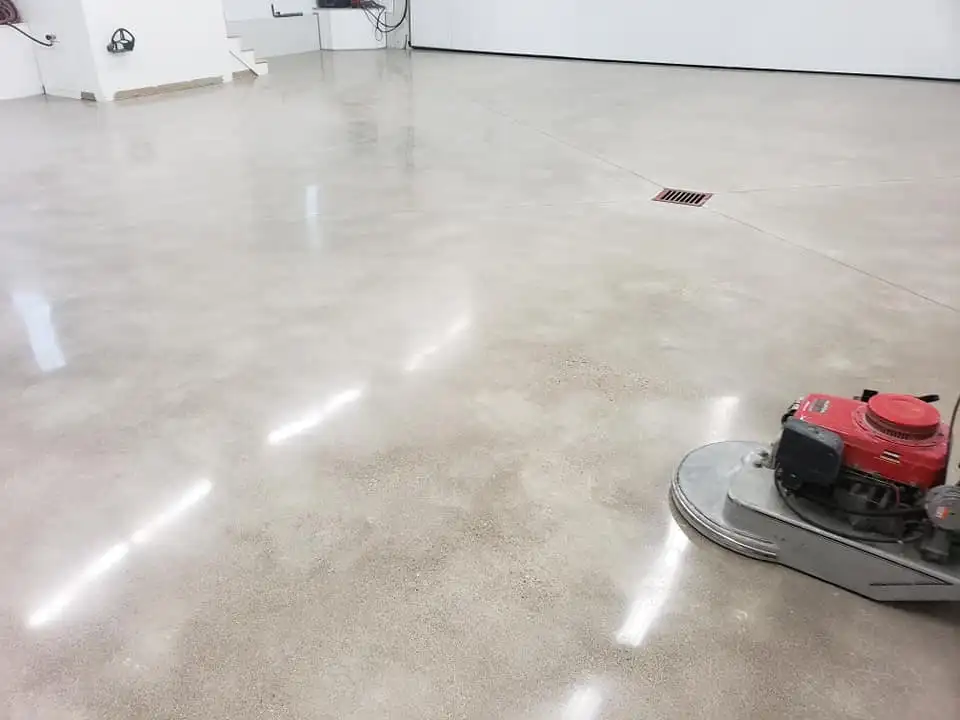Concrete polishing is a popular method for enhancing the appearance and durability of concrete surfaces. Whether you’re working on a residential, commercial, or industrial project, selecting the right tools and techniques is essential for achieving a successful concrete polishing outcome.
Here’s a comprehensive guide to help you make informed decisions when choosing tools and techniques for concrete polishing.
What is concrete polishing?
Concrete polishing, also known as diamond grinding, is the process of smoothing a concrete surface to create a more aesthetically pleasing finish.
This technique involves using specialized tools and abrasives to grind down the top layer of concrete and expose aggregate beneath. The result is an attractive shine that lasts for years with minimal maintenance.

Surface Assessment
Before you begin the concrete polishing process, it’s crucial to assess the condition of the surface. Determine the level of damage, cracks, and imperfections present on the concrete. This assessment will guide your tool and technique choices. If you’re looking for the help of a professional, try Concrete Polishing Perth and visit their site.
Type of Concrete
Different concrete mixes and compositions require tailored approaches to polishing. Identify the type of concrete you’re working with—whether it’s new, old, or decorative.
Some concrete mixes are more complex and more abrasion-resistant, while others might be softer and more susceptible to polishing techniques.
Grit Levels
Concrete polishing involves gradually refining the surface using progressively finer grit abrasives. The grit level you start with depends on the initial condition of the concrete.
Coarser grits (around 30-200) are suitable for removing imperfections, while finer grits (400-3000) create a polished sheen. Choose grit levels based on the desired finish and the concrete’s hardness.
Tools Selection
Selecting the right tools is crucial for achieving the desired polished outcome. Some common tools and equipment for concrete polishing include:
- Diamond Grinding Tools: These tools are essential for grinding down the surface and exposing aggregate if desired. Choose diamond tools with varying grit sizes for different stages of grinding.
- Polishing Pads: Resin-bonded diamond polishing pads are used for progressively refining the surface. These pads come in various grits for achieving the desired level of shine.
- Burnishing Machines: High-speed burnishers can be used to achieve a glossy finish on polished concrete. They are equipped with finer-grit pads and help in achieving a reflective surface.
- Densifiers: Concrete densifiers are chemical solutions that help in filling pores and increasing surface hardness. They can improve the concrete’s ability to take a polish and enhance its durability.

Wet vs. Dry Polishing
You can choose between wet and dry polishing methods. Wet polishing involves using water to cool the tools, reduce dust, and enhance the polishing process. Dry polishing generates less mess but can create more heat due to friction.
Your choice depends on factors such as the environment, dust containment measures, and personal preference.
Decorative Options
If your project involves decorative concrete, additional techniques like staining and dyeing might be needed.
Stains can provide a wide range of color options, while dyes can enhance the surface’s aesthetics. Consider these options if you’re aiming for a unique and visually appealing polished concrete surface.
Environmental Considerations
Ensure that your chosen tools and techniques align with environmental regulations and safety standards.
Some polishing methods might generate more dust or require chemical usage, so it’s essential to take proper precautions and follow best practices to minimize their impact.
Budget and Time Constraints
Your budget and timeline will influence your tool and technique choices. High-quality diamond tools and advanced equipment might yield superior results but come at a higher cost. Evaluate your budget and project timeline to strike a balance between quality and feasibility.
Choosing the right tools and techniques for concrete polishing involves a careful assessment of the concrete’s condition, the desired finish, the tools available, and the project’s specific requirements.
By considering factors like grit levels, tool selection, polishing methods, decorative options, and environmental considerations, you can make well-informed decisions that lead to successful concrete polishing outcomes.






